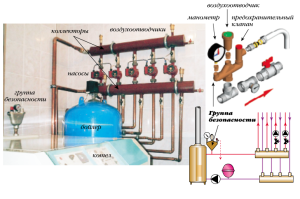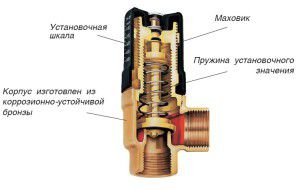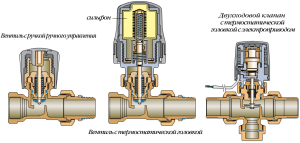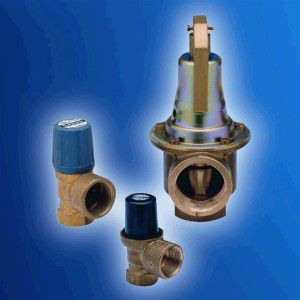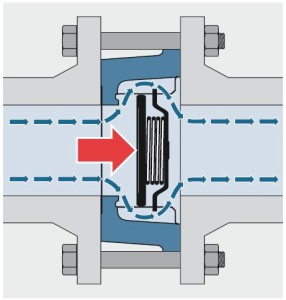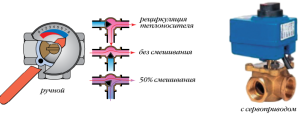Any heating system must include control and safety elements. With their help, there is a change in the parameters of heat supply - stabilization of work, automatic adjustment. For these purposes, valves for heating systems are used: balancing, return, three-way.
Appointment of valves for heating
Autonomous or centralized heat supply must adapt to the current values of the parameters - pressure and temperature in the system. To perform this task, a bypass valve in the heating system, mixing, safety and others are needed.
Unlike shutoff valves, they operate in automatic or semi-automatic mode. All heating control valves must comply with the parameters of the specific heat supply.
To do this, you must first calculate the characteristics, draw up a detailed diagram and, according to the data obtained, select the optimal heating drain valve and other types of similar elements.
The main criteria are:
- System temperature. The shut-off valve for heating should function normally even under critical thermal effects;
- Pressure - nominal and maximum. Each pressure reducing valve of the heating system has certain limits of operation, which should be below the maximum by 5-10%;
- Type of heat carrier - water or antifreeze. In the latter case, malfunctions are possible, since the air valve for heating is not designed for a liquid with a higher density than water.
A suitable valve for bleeding air from the heating system is selected at the calculation stage. The operation of this device and similar components should stabilize the system in case of a risk of emergency situations. Therefore, it is necessary to know the principle of operation and types of valves for heat supply.
Some performance specifications are indicated directly on the bypass valve body for heating. If this is not the case, professional advice is required.
Bypass heating valves
Often during operation of the heat supply, the temperature regime is exceeded. This provokes an increase in pressure and, as a result, the destruction of system components. For the timely removal of part of the coolant, a bypass valve for heating is required.
The principle of operation of this component is simple - the coolant pressure constantly affects the bypass valve seat in the heating system. When the force of the spring is less than the external pressure, the rod is displaced and some of the hot water is withdrawn. After stabilizing the pressure, the seat returns to its original position.
There are two types of heating control valves - with a constant pressure value and the ability to manually set this parameter. For autonomous heating systems, the installation of the second type is recommended, since they can be adapted to any parameters.
The pressure valve for heating performs the following functions:
- Reduces hydraulic load to the circulation pump;
- Prevents rust. When the temperature is exceeded, oxygen is released. It is the main cause of oxidation of metallic heating components;
- Reduces heat noise. Without a pressure valve for heating, water circulation can increase and as a result, vibration and noise will increase.
This item is installed only for closed systems. In gravity heating, a pressure valve is not needed for heat supply. In case of exceeding the temperature regime, the expansion of the coolant is compensated by means of an open expansion tank.
The bypass valve in the heat supply system is included in the mandatory equipment of the safety group. It is also installed at the highest point in the circuit and in critical areas.
Types of control valves for heating
Normal operation of the heat supply is not possible without a minimum set of control valves. They are designed to stabilize the heating parameters and change their values depending on the settings.
The principle of operation of pressure reducing valves of the heating system is based on limiting the flow of coolant by changing the cross-section of the pipeline. For this, the design has an adjustment head and shut-off valves. Bypass valves for heat supply are divided into the following types:
- With manual flow control;
- With a mechanical thermal head. When a thermal element is exposed to temperature, its expansion and pressure on the valve seat occur. As a result, the rod lowers, limiting the flow of coolant;
- With servo drive. To operate this type of heat control valve, the control element is connected to a control unit (programmer) or a temperature sensor. Upon receipt of a control command by means of a servo mechanism, the position of the rod changes and, as a result, the volume of coolant inflow is regulated.
These types of pressure reducing valves of heating systems allow you to change the main parameter - the temperature mode of operation. The installation of regulators is carried out in the binding of radiators, batteries, in collector units of the warm floor.
The control valve must be installed in such a way that the heat emitted from the batteries does not affect the thermocouple.
Purpose of the balancing valve in heating
Another type of control valve is a balancing valve in the heating system. Structurally, it is similar to the adjustment, but has a number of features of operation and installation.
The purpose of the balancing valve for heating is to control the volume of the coolant depending on its temperature. Their installation is optional for systems with a small length or without problems with thermal distribution. They are mounted on each heating circuit.
After mounting the shut-off valve for heating, the following heat supply indicators will improve:
- Uniform heat distribution on all heating circuits;
- Providing hydraulic system stabilizationlack of sharp pressure drop;
- Lower heating costs - fuel consumption is optimized, thermal operation is stabilized;
- After installing the balancing valve in the heating system, it becomes possible to partially or completely disconnect individual circuits from the total heat supply.
To control the current temperature pressure readings in the valve design, fittings for installation with a thermometer or pressure gauges are provided. Depending on the design, the adjustment of the coolant flows is carried out in manual or automatic mode.
Balancing valves are mounted in the collector systems of private houses or in two-pipe heating of an apartment building.
Safety heating valves
In addition to the heating bypass valve, for the normal operation of the system, installation of other types of control and protective valves is necessary.During operation of the heat supply, an excess of air may appear, the reverse movement of the coolant will occur. To prevent these phenomena, it is necessary to foresee the installation of an air valve for heating and return.
Depending on the functional purpose, there are two types of safety valves - to remove air from the system and prevent the reverse movement of water in the pipes. Without these elements, the operation of the system can be unstable, which will lead to a violation of the temperature regime, destabilization of pressure and the creation of emergency situations.
Safety valves are installed in the following areas of the system:
- In places with the greatest likelihood of overpressure - after boilers, circulation pumps, on manifolds;
- On the return pipe, a heating ball valve or its flap analogue is mandatory mounted. It is also necessary to install this component in the piping of the circulation pump;
- At the highest point in the circuit, to remove air from the system. A Mayevsky crane is installed on radiators and batteries.
Safety valves should not impair the performance of the heating system. First of all, they eliminate possible malfunctions in the heat supply. In the "inactive" state, these components of the system should not impair the speed of the coolant, affect the temperature regime.
To prevent a sharp pressure drop in the make-up unit, the heating bleed valve must be installed. It will prevent a sharp jump in pressure.
Heating air valve
During operation of the heat supply, air locks may form in the pipes and radiators. The reason for this is the high oxygen content in the water, the temperature of the coolant above + 100 ° C. As a result, the oxidation of metal components occurs, the temperature distribution changes. To avoid these situations, valves must be installed to vent air from the heating system.
First of all, the air valve for heat supply is mounted in the safety group together with a bleed and pressure gauge. In the heating scheme, they are located on a straight branch leading from the boiler. In this place, the highest temperature of the coolant, as well as the maximum pressure. In the collector scheme, the installation of heat drain valves on each comb is mandatory.
Air vents are divided into two types, each of which is designed for installation in certain areas of the system:
- Mayevsky crane. It is installed in a radiator (battery) and is needed to remove air jams;
- Automatic air vent. It is mounted at the highest point in the system, as well as in security groups. Air flows out of the heating system through it.
For the latest model, it is important to comply with the operating conditions. After a long downtime, it is likely that some moving components will “stick” and then the air vent will not work. In order to avoid this, a structural inspection should be carried out regularly and, if necessary, replaced with a new one.
Most valve models for bleeding air from a heating system are designed for pressures from 0.5 to 7 bar.
Heating check valve
In gravity systems and in heating circuits without a circulation pump, there is always the possibility of a change in the direction of movement of water. In this case, the boiler heat exchanger may be damaged due to overheating, as well as failure of other components. To prevent such situations, a check valve is mounted.
In large heating circuits, a heat supply ball valve is installed. Under the action of the reverse flow of water, a ball of polymer blocks the pipeline, thereby preventing the movement of the coolant.As soon as the direction changes, it falls under the influence of gravity. The electromagnetic valve for the heating system works in the same way. The difference lies in the control element - a solenoid or an electromagnetic coil is used for this.
The advantages of installing an electromagnetic valve in a heating system are as follows:
- Ability to connect to the programmer;
- Setting the response mode of the device depending on external factors - temperature or pressure;
- Reliability of work.
The disadvantages of electromagnetic valves in heat supply is their dependence on the supply of electricity. In autonomous heating, a spring version of the check valve is used. The water pressure constantly acts on the saddle, squeezing the spring. As soon as the direction changes, there will be an automatic shutdown of the coolant movement.
In forced circulation systems, a non-return valve is mounted on the bypass pipe of the pump assembly to prevent a change in fluid flow in the line.
Three way heating valve
To adjust the water temperature in a two-pipe and collector system, a three-way mixing valve is installed in the heating system. It connects to the feed and return pipes.
The principle of operation of the three-way mixing valve in the heating system is to mix hot and cold water in the pipelines. This allows you to set the required level of heating medium without changing the mode of operation of the boiler.
The determining factor in choosing a three-way valve model is the control element, which can be of the following types:
- Hydraulic;
- Pneumatic;
- Electric.
In autonomous heating, models with an electric drive are most often installed. They can be connected to the control elements of the system. It is important to set the mixing mode correctly so as not to degrade the heat supply parameters.
The selection and installation of heating valves should only be carried out after an accurate calculation of the system. As a result of this work, the parameters of all components are determined, and based on these data, a choice is made from existing models.
For a better understanding of the functional features of the three-way valve, it is recommended to familiarize yourself with the video material:
